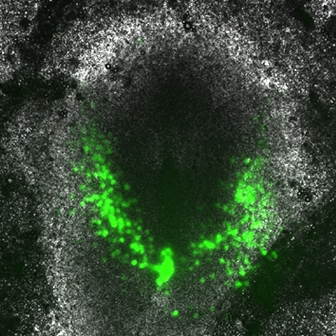UEA research identifies molecules that guide embryonic heart-forming cells

Image above shows an early chick embryo with prospective heart cells labeled in green. These cells are migrating towards the region where they will form the heart.
The heart is the first functioning organ to develop in humans, and correct formation is crucial for embryo survival and growth.
New research published today reveals how cells that form the heart, known as ‘cardiac progenitors’, are guided to move into the right place for the heart to begin to form.
It is hoped that the findings will help researchers better understand how congenital heart defects happen during the early stages of pregnancy.
Researchers studied live chick embryos and used a fluorescent dye to follow how prospective heart cells move together under the microscope.
Lead researcher Prof Andrea Münsterberg, from UEA’s School of Biological Sciences, said: “We have identified two important molecules which work together to control the correct migration of these cells.
They do this by responding to signals, which help the cells navigate their way together – a bit like the embryo’s own GPS system. Once they have arrived in the correct place, they can begin to form the heart.
“Exactly how the cardiac progenitor cells are guided in their movement by these external signals is still unclear, but we have identified two key players that are important in this process.
“This research is particularly important because correct heart formation, at the right time and in the right place, is crucial for embryos to survive and grow.”
The research was funded by British Heart Foundation project grants.
‘Smad1 transcription factor integrates BMP2 and Wnt3a signals in migrating cardiac progenitor cells’ is published in the journal PNAS (Proceedings of the National Academy of Sciences) on May 5.
Media Contact
More Information:
http://www.uea.ac.uk/mac/comm/media/press/2014/may/heart-cellsAll latest news from the category: Life Sciences and Chemistry
Articles and reports from the Life Sciences and chemistry area deal with applied and basic research into modern biology, chemistry and human medicine.
Valuable information can be found on a range of life sciences fields including bacteriology, biochemistry, bionics, bioinformatics, biophysics, biotechnology, genetics, geobotany, human biology, marine biology, microbiology, molecular biology, cellular biology, zoology, bioinorganic chemistry, microchemistry and environmental chemistry.
Newest articles

A universal framework for spatial biology
SpatialData is a freely accessible tool to unify and integrate data from different omics technologies accounting for spatial information, which can provide holistic insights into health and disease. Biological processes…

How complex biological processes arise
A $20 million grant from the U.S. National Science Foundation (NSF) will support the establishment and operation of the National Synthesis Center for Emergence in the Molecular and Cellular Sciences (NCEMS) at…

Airborne single-photon lidar system achieves high-resolution 3D imaging
Compact, low-power system opens doors for photon-efficient drone and satellite-based environmental monitoring and mapping. Researchers have developed a compact and lightweight single-photon airborne lidar system that can acquire high-resolution 3D…





















